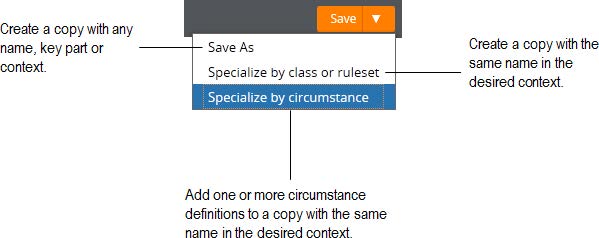Create, Save As, and Specialization forms
Valid from Pega Version 7.1.4
The familiar “New” and “Save As” forms have been streamlined to make record creation faster and more intuitive. You can easily target a specific layer in your application stack, interactively define the record’s configuration and select only those circumstance definitions that make sense for your use case.
While the underlying behavior for creating a record is not new for this release, the redesigned UI of these forms and new defaulting strategy for fields is worth noting:

To launch these forms, use one of the new options found in the action area of the form header:

Note that not all record types support the ability to specialize by circumstance.
For more guidance on how to use the Create, Save As and Specialization forms, please refer to: Intuitive record creation and specialization
Redirect users to logout screen
Valid from Pega Version 7.1.4
New applications built in Version 7.1 will automatically redirect users to the PRPC login page upon logout.
A new template, Web-Session-Return-Template, has been added, to allow developers to customize their applications to redirect users to a logout page, if they wish. This template can be copied to a ruleset visible to unauthenticated requestors (via node configuration) and used to override Web-Session-Return.
Execute Tests service now supports flows, case types, and PegaUnit test suites
Valid from Pega Version 7.3
The Execute Tests service now supports running flows, case types, PegaUnit test suites. Use the Execute Tests service to validate the quality of your builds after every build run.
For more information, see Running PegaUnit test cases and test suites with the Execute Tests service.
Support for creating PegaUnit test suites
Valid from Pega Version 7.3
You can now create PegaUnit test suites to group related PegaUnit test cases and run them in the order that you specify. For example, you can create smoke tests to verify that critical application functionality is working as expected.
For more information, see PegaUnit test suites.
Enable and disable functionality with feature toggles
Valid from Pega Version 7.3
You can enable and disable functionality in your application for development and testing by creating feature toggles on the Toggle Management landing page. You can also manage the toggles in your application from the landing page. For example, you can review the toggles that you want to retire at the end of a release, or migrate a toggle to other applications by changing the associated ruleset.
For more information, see Creating a toggle.
Support for following users in the Pega Express and Case Manager portals
Valid from Pega Version 7.3
You can now follow users in both the Pega Express and Case Manager portals. Posts that are made by users whom you are following are displayed in your Pulse activity feed in your dashboard. In addition, an icon indicates whether followed users are online.
For more information, see the following help topics:
Enhancements to the Send Email smart shape
Valid from Pega Version 7.3
The following enhancements have been made to the Send Email smart shape:
- You can now configure the Send Email smart shape in Pega Express.
- You can use templates, such as a rejection template, in your email.
- You can use property values, which allow you to insert the value of a field in your case type, such as First Name, within the email.
- You can insert a link to the case ID in your email.
- You can more quickly configure your recipient list by using two options, instead of one, to send messages to either a list of email addresses or to fields.
- You can choose to send either all case attachments in an email, or you can send attachments of a specified attachment category or an attachment type field. You can specify multiple attachment categories and attachment type fields.
For more information, see the following help topics:
Improved requestor management
Valid from Pega Version 7.3
From the Requestor Management landing page, you can now manage active requestors and debug their activity on all nodes in the cluster, including the current node and remote nodes. You can view performance and requestor details; start the Tracer or Clipboard tool; profile, interrupt, or terminate the selected requestor; and estimate the data size of all requestors on the selected node.
For more information, see Managing requestors.
PegaUnit testing now supports flows, case types, and additional assertions
Valid from Pega Version 7.3
You can now create PegaUnit test cases for flows and case types to verify that the rule returns the expected output when you run the test case.
Additionally, you can use the following new assertions
- Assigned to – Verifies that the case is routed to the appropriate operator or work queue.
- Case status – Verifies the status of a case.
- Attachment exists – Verifies that an attachment exists.
- Case instance count – Verifies the number of case types, such as child cases, that are created when the test case runs.
For more information, see PegaUnit test cases for flows and case types.
Remotely start automation server jobs to perform branch operations
Valid from Pega Version 7.3
You can remotely start a job on your automation server, such as Jenkins, after an activity has occurred, for example, after you push a branch to a remote system of record. You can configure a continuous delivery pipeline on the job by using the branches REST service and merges REST service to detect conflicts, merge branches, and return the status of the merge. By remotely starting a job to detect conflicts and merge branches, you can more quickly deliver higher-quality software.
For more information, see the following PDN articles:
- Using branches with Pega repositories in a continuous integration and development pipeline.
- Remotely starting automation jobs to perform branch operations and run PegaUnit tests.
- Performing branch operations in a continuous integration and delivery pipeline with REST services.

